
By Sebastien Hayez. Published January 15, 2023
History of Typefaces
Typeface, history of a family
Today, the few cases of typefaces available in a single style are bachelor in the market. It has become an implicit norm to deliver a typeface in several styles, even if it is only a bold or an italic, and no commercial typeface would find its audience without its variations in weight and slant.
However, this notion of family has never been obvious and the technical possibilities of typographic creation software totally liberate the design of an extended family.
I. Family members: classicism
If we narrow our focus to the Latin alphabet, the Roman capital, as engraved on the Trajan column, appeared as the model for the centuries to come. Until the reign of Charlemagne, around 800, Latin writing influenced by the flat pen on parchment took on a more fluid and curved form, facilitating rapid drawing. However, the alphabet remains unicameral: although its shape resembles our lowercase letters, it is merely the evolution of Roman capitals.
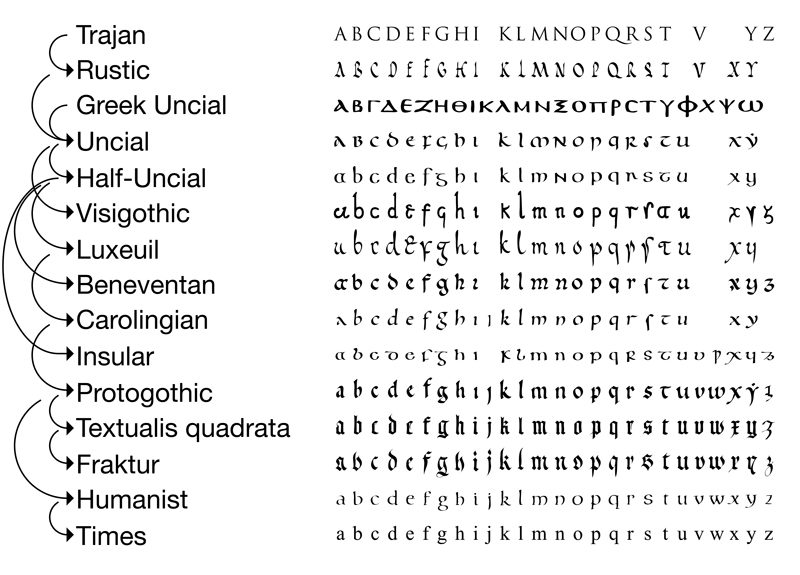
In prestigious writings, religious as well as diplomatic, and written in Caroline, the first letter of each sentence is an ornamented initials that stands out from the rest of the text. This decorative demonstration also has its interest since it indicates explicitly, and at a glance, the beginning of the sentence. However, the lettering and the body text share a unique graphic style.
It was not until the twelfth century and the blackletter script that the use of the initial capital letter at the beginning of a sentence became widespread, but above all a different spelling between upper and lower case letters, the former taking on an ornamental form when the latter were simpler in their layout. It is during this period that the Latin alphabet becomes bicameral: upper and lower case letters functioning as variants of hierarchy and no longer of historical evolution.
The Renaissance and especially the invention of the printing press will further standardize the uses of the letter. Booksellers became printers and publishers (the term appeared at the beginning of the 19th century in England), establishing the best translations and ensuring that the text was as accurate as possible. Thus, the first incunabula used a bicameral alphabet, although some editions combined typographic text with hand-painted lettering to imitate the prestige of handwritten codices.
Although blackletter script was the norm throughout Renaissance Europe, Italy was more resistant to this evolution and the master writers and calligraphers of the peninsula preferred to draw inspiration from a more glorious past. Antiquity served as a model for architecture and fine arts in general, but it was the Carolingian era that the first humanists were looking for. The writing of chancellery, specific to diplomatic and especially commercial writings, is the great instigator of the generalization of the lower case, especially since the years 1420 and Niccolò Niccoli. It is presented in the form of a calligraphy inspired by Roman capitals and Carolinian lower case letters but inclined to the right under the effect of the expedited gesture. Aldus Manutius (1449-1515) was inspired by it for the publication of the first in-octavo, thus drawing an obvious handwritten inspiration but also taking advantage of the relative width of these characters compared to the blackletter writing: within a reduced format, the text keeps its handwritten aspect, while condensing a rich text.

Italy, in the France of François Ist, remains the model to be equaled, both in the arts and in typography. Claude Garamont (1510-1551) or Nicolas Jenson (1520-1580) became the typographic designers capable of reconciling Italian humanist influence and French elegance. The Roman typefaces of these two men are still praised today for the perfection of their balanced designs.
Thus, during the Renaissance, one does not yet speak of a typographic family but rather of a set of typefaces designed by a single person and having Roman, italic, if not Greek or Hebrew characters for scholarly documents. The homogeneity of the surface is due to the personality of the creator but especially to his national and historical culture.


Above all, the real unity of a Renaissance typography lies in its various type sizes, all named according to a delicious nomenclature: gros-parangon, nonpareille, minionette, canon, etc. Each type size is designed to compensate for the effects of printing on the paper. In fact, each type size was designed to compensate for the effects of printing on the paper. Thus, a body of 6 pts enlarged will give neither the body 12 nor the 60 pts. These optical corrections already prefigure the notion of family by establishing the typographic furniture as the logical grouping of the various optical sizes.
It is still in France, probably under the reign of Estienne, that the edition will generalize the use and the writing of the French language. Roman and italics within the same paragraph are codified in order to separate two levels of text: for example, the use of foreign locution and French, between text and quotation, etc. In the same way, Geoffroy Tory (1480-1533) proposed a complete and standardized punctuation, the addition of diacritics, and a reform of French spelling.

France is still one of the countries at the forefront of typographic reforms, thanks in particular to Pierre Simon Fournier le Jeune. The latter is the inventor of a measurement system corresponding to the current typographic point, but also one of the first to conceive his alphabets as a whole: the various sizes, the roman and the italic, ornate letters, but also a script, borders, vignettes and ornaments are included. The overall harmony is thought out in advance in order to design the book according to a set of appropriate tools.

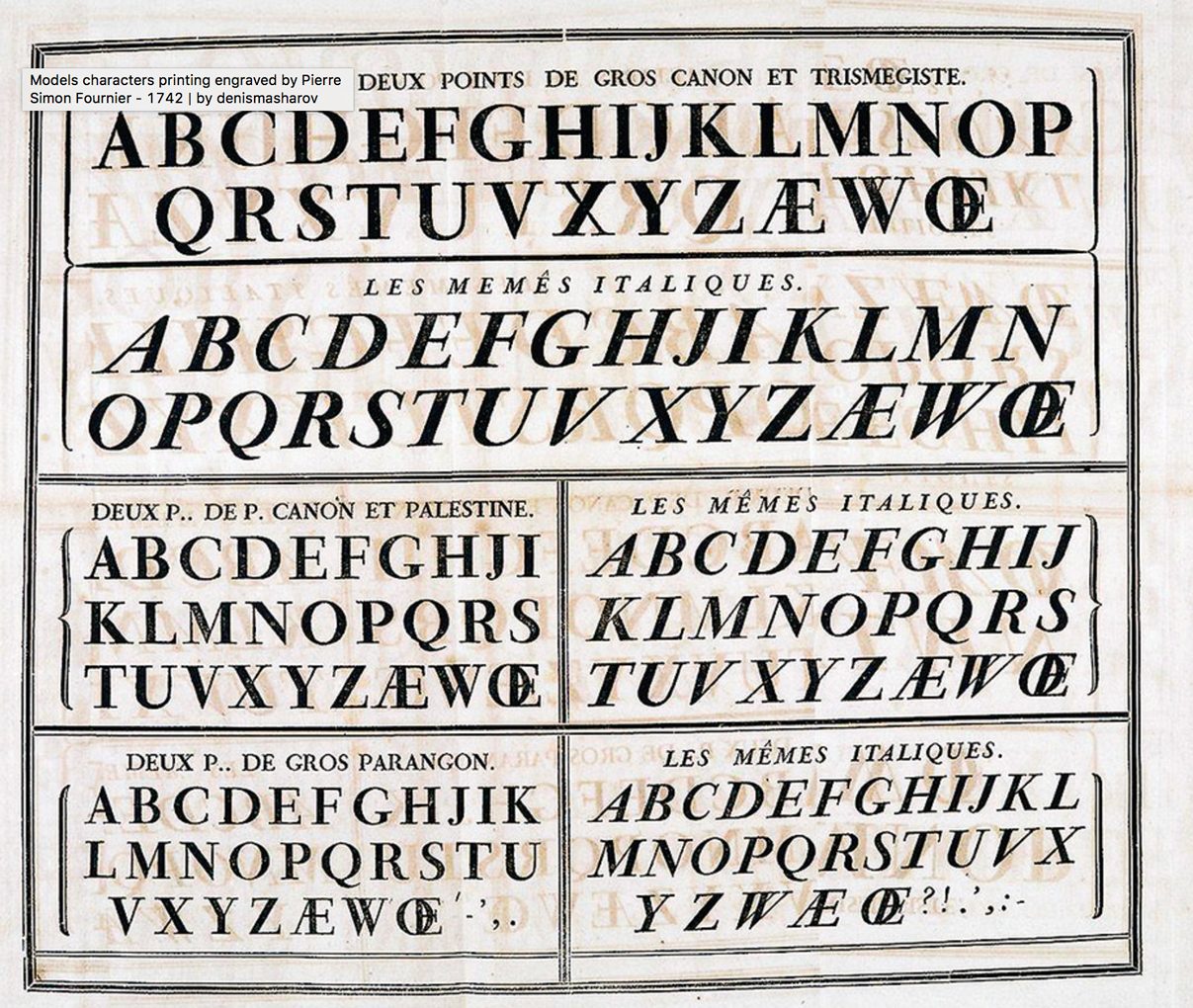
A few decades later, the Didots, continuing Fournier's advances in terms of units of measurement and typographic designs, came up with a system incorporating lean and fat.
The portrait is quickly painted of all the members of the family: capital and lower case, roman and italic then bold.

II. The traditional family: the industrial era
From the appearance of printing in the West until about the 19th century, typographic design remained unchanged: a designer drew inspiration from the past to reformulate in a new context a typeface capable of reflecting the culture of a given time and place. And if Elzevir, Caslon, Fournier, Baskerville, Didot, Bodoni and then other designers provide their alphabets, none of them are thought to belong to the same family. Their homogeneity is due to the tradition as much as to the know-how of each creator.
The only common point is that typography during these many centuries is the quasi monopoly of the edition. The poster, although present, is a communication tool of power reserved for the states.

The pivotal point occurs when the industrial revolution and mechanization allow for changes in production processes. The task is segmented, automated; the renderings are homogeneous for mass production and in large quantities. Faced with these production costs and this volume, the market must be considered outside a reduced geographical area. Printing, also affected by the industrial revolution, is automated and prints for a lower cost leaflets, posters, labels, magazines, able to carry far the voice and the image of the emerging modern brands on several continents.
Addressing a large public in a context of fierce competition, companies were looking for any price to reflect their innovations in the typefaces of the time. The first modern type foundries were created and provided printers with a large catalog, including both publishing classics and fancy typefaces, either cast or engraved in large sizes. It is in this industrial context that the editorialization of typefaces will group together under the term of family styles previously attached only to certain cultures, to certain creators. The Didot typefaces are thus grouped in roman, italic and in various weights, thus making it possible to hierarchize the text with more flexibility or to emphasize one or more words within a paragraph.
Still, even the very traditionalist milieu of publishing will emancipate itself from the past to put on the page works overloaded with ornaments satisfying the taste of the new bourgeoisie who have recently reached the privileges of bibliophily.
Still for advertising purposes, sans serif typography exploded on posters covering entire city walls. And in order to make the best use of the whole surface, variants from condensed to extended styles multiply. From a small family to a large one. The goal of a type foundry is no longer to respect tradition (roman, italic, historical typefaces) but to provide tools to adapt to all contexts, from classical publishing to modern advertising. Moreover, this graphic exuberance is encouraged by a liberated commercial spirit: variants can be added under the pressure of the printers and at the request of the foundry. For all that, the declination in weight and width is not necessarily entrusted to its author but to small hands less scrupulous and faithful to the original drawing.
Akzidenz Grotesque, for example, unfolds in a family of four weight and several width, three of which are condensed and three extended, between its first publication in 1898 and 1906.
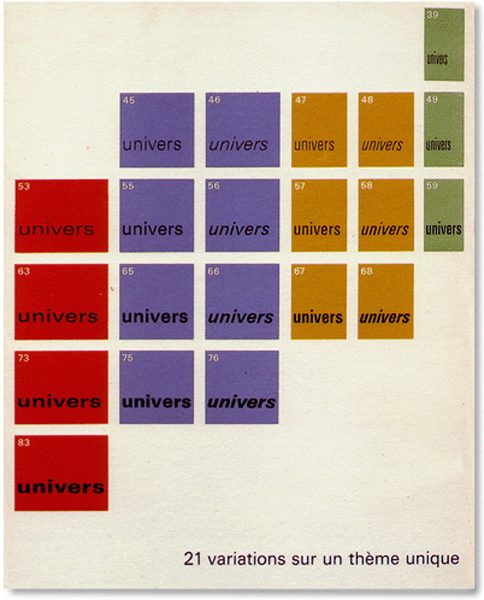
Until 1957, type designers remained artists working as craftsmen: the eye was their only judge of the accuracy of a curve or a weight. However, when typeface families were advertised in specimens, in the pages of magazines or on promotional posters, the scale of the work proved to be titanic. In order to provide the best work in a short time, the young Swiss Adrian Frutiger (1928-2015), then hired by Charles Peignot at the French foundry Deberny & Peignot, will take back his sketches drawn during his training at the Kunstgewerbeschule of Zurich to give birth to the Univers in 1957, a family of 4 weights, 4 width and 7 obliques. When Peignot asked him to finalize the drawing of the whole family as quickly as possible, Frutiger took up his copy and thought of a system allowing him to have an overview of each glyph declined according to these 21 styles. He then draws curves showing the progression between each point of each character. The space between each point is calculated in a rational way: the artist-craftman operates like an engineer. This method, although personal and mathematical, will become the standard in the profession and each extended typographic family is designed by respecting the logic set up by Frutiger but inherited from a past and empirical tradition.
III. The blended family: the limits of modernism
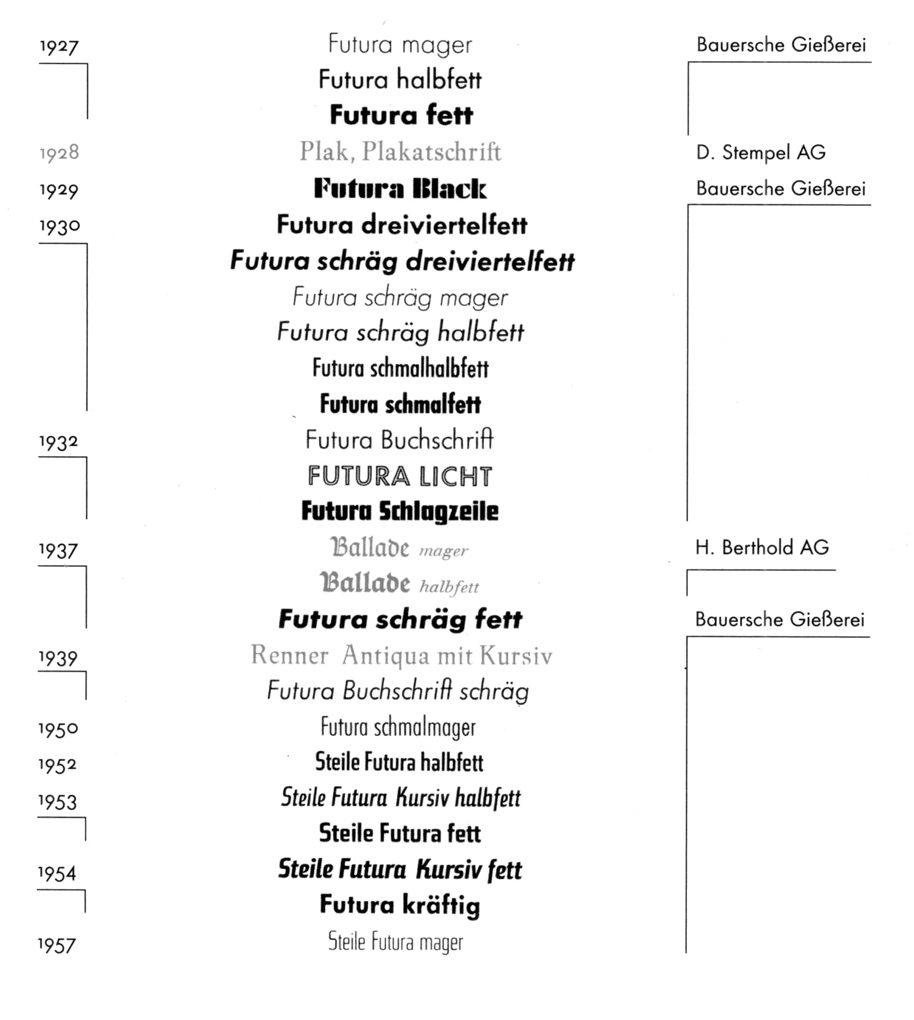
The modernism of the 1920s and 1930s was an avant-garde in typography: the formal experiments or those seeking to create universal alphabets are proof of this. Before the appearance of Frutiger's Univers in 1957, Futura was praised by the profession as an excellent sans serif typeface capable of being used for both advertising and publishing. As early as 1924, Paul Renner sketched out a geometric alphabet with radical forms that led, three years later, to the publication of the first weights. Throughout his career, Renner will under pressure from Bauer Type complete the family of a set of relatively disparate styles. On the one hand, Futura in its purest form is declined in its weights of light, semi-bold, bold, ¾ bold, and progressively in its italic and condensed declinations. But on the other hand, from 1929 the Futura Black breaks the logic by presenting an atypical typeface, a kind of geometric stencil typically Art Deco. The infidelities were repeated in 1932 with the Futura Licht (enlightened) and the Display.
It is difficult to know the reasons for this typographic expansion. The success of the typeface in Germany, in Europe and then throughout the world established Futura as a trademark (protected in 1953) and attracted the attention of the profession, which was then affected by an international crisis. As a proof, the Steile Futura, although designed by Renner, is totally foreign to Futura, so that it is known under other names abroad: Bauer Topic for the UK and the USA, Vox in Spain, and finally Zénith in France.
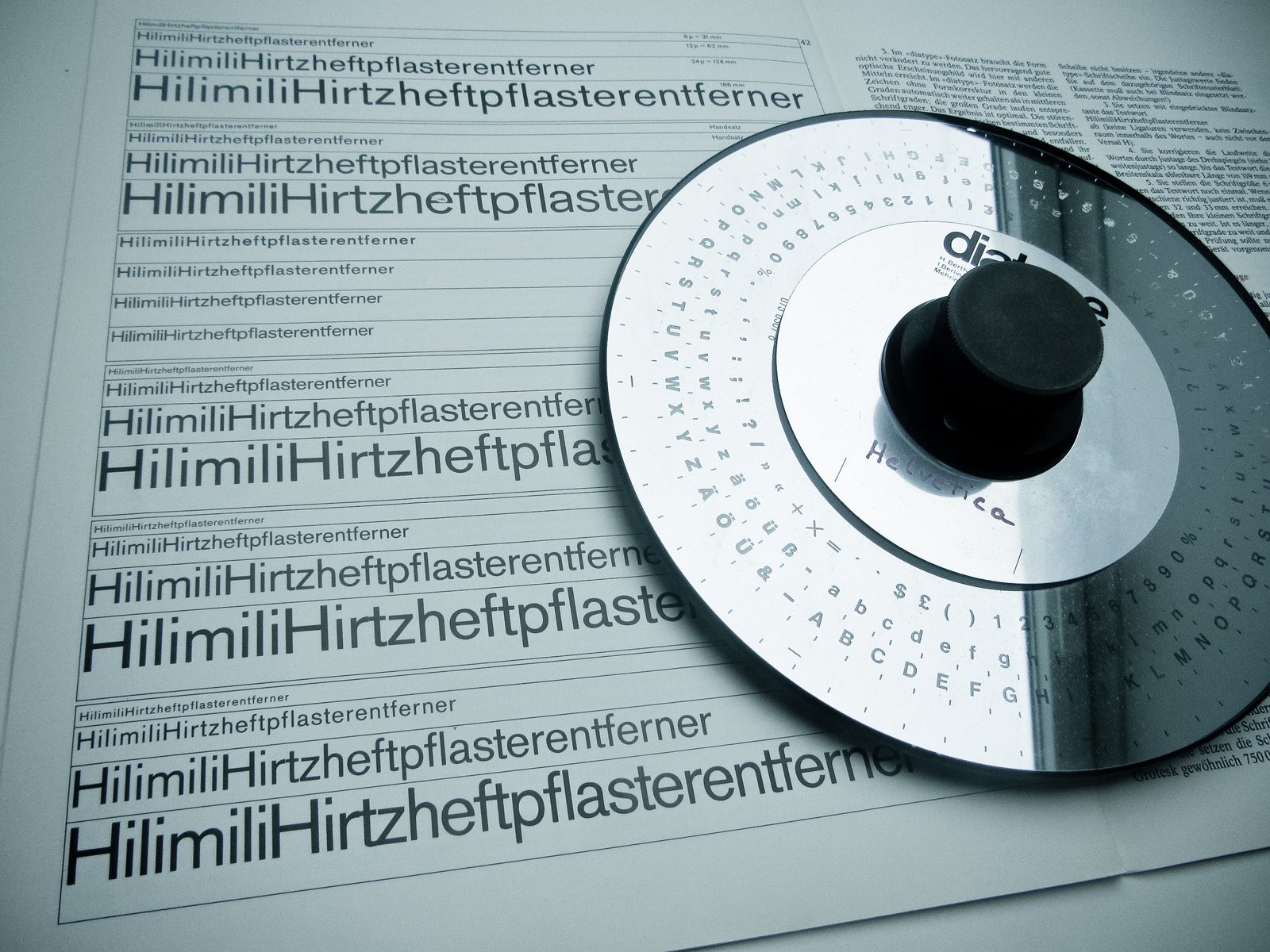
In the post-war period, modernism quickly ran out of steam in the face of the contradictions of unbridled capitalism. The youth, from the middle of the 1960s, asserts itself in designs rejecting this modern formalism becoming a new tradition: colors, forms, music are judged as contestative but define what will become a vast subculture.
In the same logic, typography is reinventing itself as much through its young generation of professionals as through new technologies: after 500 years of movable typography, phototypesetting allows lettering designs on film to become the matrices for flashing and then offset printing.
Dematerialized, the typography loses however in finesse. Indeed, the same matrix in 6 pts size is enlarged to provide all the sizes, thus forcing the type designers to make the exception a standard: the counter-forms are open, the serifs are marked, the slashes are thick, so that in small sizes the typeface remains readable.
But phototypesetting also liberates typography by allowing effects, outlines, patterns, etc., so many fantasies that will mark the breakup of the concept of family.

In 1988, however, it was the pope of German modernism Otl Aicher (1922-1991) who published a family that broke with tradition even more. Rotis brings together serif, sans-serif, semi-serif and semi-sans-serif styles, thus bringing together the antagonism of classical typography in a coherent style. Aicher proves that the logic of the past is not necessarily relevant today. Tradition, if it is to endure, must be understood and reinterpreted while retaining its essence.
This is not an isolated case, since Summer Stone published ITC Stone in 1987 in both sans serif and serif versions, and in 1988 in ITC Stone Informal. The commercial success as well as the notoriety of the designer prompted the publication in 2005 of the ITC Stone Humanist.
History frequently repeats itself by intertwining technological progress and artistic creativity. For example, 1984 marked the introduction of the Apple Macintosh and the birth of Emigre, Inc., a digital foundry established in Berkeley by Rudy VanderLans (1955-) and Zuzana Licko (1961-). The California firm now appears to be the prototype for most independent type foundries. The digital experiments of the beginning offer an immense formal freedom that totally redesigns the relationship to the text, at the time of MTV and cable channels but also of the beginning of the internet. Finding logic in the apparent chaos of postmodernism seems unrealistic.
In response to Emigre, the guardians of the modernist tradition respond with projects in which the computer perfects what Frutiger imagined to be done by hand. Through a game of interpolations between styles, the designer obtains the intermediate nuances. A family composed of a light, a normal and a black, allows to obtain thanks to the Multiple Master technology a vast panoply covering the intermediate weights. The case of Lucas de Groot's Thesis is the demonstration of such a philosophy. Conceived between 1994 and 1999, the family is deployed on a vast set of styles: TheSans and its variants Mono and Typewriter (33 styles), TheSans SemiCondensed (16 styles), TheSans Condensed (16 styles), TheSerif (16 styles, then again 32 styles for the SemiCondensed and Condensed), and TheMix (64 styles in total). In the end, the family includes 177 children, to which we must add the style variants offered by TheAntiqua and TheStencil.

Since 2016, superfamilies have become widespread thanks to the new Open Type 1.8 standard including Apple's TrueType GX variations and simply called Variable Font. Interpolation passes to the side of the user, who, through a set of sliding rules, will refine the typography according to criteria thought by the designer. In a much more relevant way, optical corrections, abandoned since the phototypesetting era, find their raison-d'être here. Indeed, the CSS parameterizing the styles of the web pages also allows the programming of the display style according to the size of the screen and thus to the display terminal. You are surfing on a site from your smartphone, in this case the designer must indicate the display of the typography with an adapted optical body.
Of course, creativity is also a way of turning the useful into the unexpected, and variable typography also exploits interpolation in a much more fanciful way than varying weights, casts, optical bodies, or slants.
Some typographies take advantage of progressive variations of interpolations in order to establish an animation of the letter by slight deformation, by flashing of a vignette pattern, or by metamorphosis of a glyph into another. The use might seem absurd in the case of printing, but dynamic screen display allows animation by scrolling the screen or any other ingenious process programmed in CSS.
Tracing the overall plan of the evolution of the notion of typographic family teaches us a lot about our uses of text. From a handwritten writing characterized by the respect of forms evolving according to the geographical and historical cultures, the craft of the first printers standardized the form of the letter and its printed use, thus respecting a social prestige associating the written word and a certain idea of the tradition. Thereafter, the commercial uses of the industrial revolution, by their research of visibility, exploit less conventional uses but taking more into account the formal characteristics of the letter: grease, hunting, inclination. A certain modern maturity finally brings the reasoned method allowing to conceive effectively the whole of these styles. Contemporary computer technology only automates and makes the task easier and faster and pushes the uses in an unexpected return to the respect of traditions, while allowing the game.
Today, it is difficult to imagine the future of typography. A digital typography file already contains a set of glyphs with several writing systems, styles and variant sets. Extending these possibilities to more glyphs would be quite possible, but it is the uses that definitely dictate the technological and design evolutions. The web has become our main communication medium, relegating print to a secondary and more perennial medium, still guaranteeing a certain prestige.
To a lesser extent, 3D printing applied to letters is still anecdotal, and one could naturally think that the production of printing dies on demand or the realization of signs and signage in volume remain sectors to be exploited.
The exploitation of artificial intelligence is still experimental and the artistic uses are still in the realm of the playground generating unexpected forms and not necessarily exploitable as such in a professional setting.